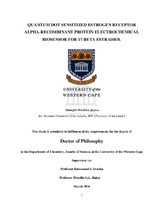| dc.contributor.advisor | Iwuoha, Emmanuel | |
| dc.contributor.advisor | Baker, Priscilla G.L. | |
| dc.contributor.author | Jijana, Abongile Nwabisa | |
| dc.date.accessioned | 2016-11-22T15:42:48Z | |
| dc.date.available | 2016-11-22T15:42:48Z | |
| dc.date.issued | 2016 | |
| dc.identifier.uri | http://hdl.handle.net/11394/5330 | |
| dc.description | Philosophiae Doctor - PhD | en_US |
| dc.description.abstract | Estrogens play an extraordinary role in the endocrine system regulation through the stimulation and regulation of endocrine pathways. 17β-estradiol is one of the final metabolites in estrogen regulation by hydroxylase enzymes that are well recognized for their metabolic role in hormone fragmentation and dissociation, through hydroxylation reactions that reversibly convert a series of androgens to estrogens (i.e. or one estrogen to the other). However, the 17β-estradiol hormone has been classified as one of the estrogenic endocrine disrupting compounds {i.e. EDC (s)} that show significant adverse effects in the estrogen pathways of male and female animal species. Estrogen receptor alpha (ER-α) is significantly activated by 17β-estradiol, which is a steroid hormone. A biosensor system for the determination of 17β-estradiol was developed based on the highly selective and specific physiological substrate level activation of the ER-α biomolecule by the (17β-estradiol) compound. The chemically-tuned tin selenide quantum dots capped with 3-mercaptopropionic acid were produced at room temperature and employed to capture the ER-α micro-molecule onto the electrode surfaces. These quantum dots possessed average particle size (APS) diameters between 4.6 ± 0.6 nm and an indirect band gap energy (Eg) of 3.14 eV. Surface modification on the quantum dots permitted the formation of efficient amide bonds between the capping molecules of the quantum dots and the estrogen receptor-alpha. The tin selenide quantum dots platform enhanced the surface bio-reactivity of the receptorsensor film. The receptorsensor’s sensitivity towards 17β-estradiol was 5.9 μA/μM associated with a response time (tResponse) of less than 1.2 s. The formal potential, Ep˚ˈ, of the receptorsensor-substrate complex was 149 mV. A detection limit (DL) of 1.9 nM was obtained for the electrochemical biosensing methodology. 17β-estradiol–receptorsensor response kinetics were also evaluated, where a dissociation rate (kd) of 7.6 μM/s, a 50 % inhibition concentration (IC50) value of 3.4 nM and a binding efficiency (Bmax) of 7 nM were obtained. Effective measure of 17β-estradiol concentrations as low as 3.8 nM present in surface waters have been reported to induce feminisation in male aquatic species. The receptorsensor’s dynamic linear range (DLR) nevertheless showed capability of screening a minimum of 0.2 nM to a maximum of 8 nM of the 17β-estradiol concentrations. Furthermore, during the estrogen replacement therapy (ERT), 17β-estradiol concentration levels are monitored at frequent phases, wherein 17β-estradiol concentrations from as low as 0.37 nM are recovered in the serum (i.e. this value was also evaluated to be within the receptorsensor’s-DLR), determining its future capability to be developed for; clinical-diagnosis screening of the 17β-estradiol. | en_US |
| dc.language.iso | en | en_US |
| dc.publisher | University of the Western Cape | en_US |
| dc.subject | Amino acids | en_US |
| dc.subject | Proteins | en_US |
| dc.subject | Fluorescence spectroscopy | en_US |
| dc.subject | Estrogen--Receptors | en_US |
| dc.subject | Estrogen receptor-alpha (ER-𝜶�) | en_US |
| dc.title | Quantum dot sensitized estrogen receptor alpha-recombinant protein electrochemical biosensor for 17-beta estradiol | en_US |
| dc.type | Thesis | en_US |
| dc.rights.holder | University of the Western Cape | en_US |

